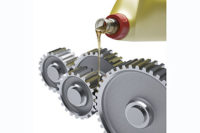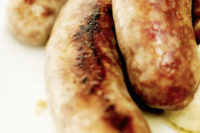
Trees are turning green, flowers are starting to bloom and a cold winter is coming to an end. Before long (in some places it is already happening) grills will be fired up and cookouts will abound.
Bratwurst is a long-time summer favorite for outdoor cooking. The name bratwurst is derived from Old High German. Wurst means sausage and brat means meat (sometimes defined as chopped meat or pure meat).
Because it did not contain nitrite and consequently had a white external color, sometimes fine-ground cooked bratwurst was referred to as a white sausage. Traditional German bratwurst was typically made from pork and veal. In the U.S. bratwurst is most frequently made from all pork. However, it is not uncommon for bratwurst to be manufactured from turkey or chicken. Beef is also found as an ingredient in bratwurst.
Bratwurst is great either as an entrée or served on a bun; not just any bun, but rather a bratwurst bun which is slightly larger than the typical hot dog bun. In Germany bratwurst is often served on a hard roll.
Styles of Fresh Bratwurst
• Coarse ground, uncured (no nitrite), natural or collagen casing
• Fine ground, uncured, natural or collagen casing
• Coarse ground, uncured, skinless
• Coarse ground, uncured, patties
Styles of Cooked Bratwurst
• Coarse ground, uncured, natural or collagen casing (white sausage)
• Fine ground, uncured, natural or collagen casing ( white sausage)
• Coarse ground, cured (with nitrite), natural or collagen casing
• Coarse ground, cured, natural or collagen casing, with added cheese, fruit or vegetables
Any combination of pork skeletal meat with an overall fat content of 25 to 30 percent will produce an excellent bratwurst that is juicy and has good texture. Very lean bratwurst (10 percent fat) can tend to be a little dry and chewy while fatty bratwurst (40 percent fat) tends to be greasy. Meat from sows makes excellent bratwurst because as an animal increases in age the amount of muscle pigment, myglobin, increases. This higher level of pigment in sow meat gives the bratwurst a rich meaty color.
Typical non-meat ingredients in bratwurst include salt, sweetener and spices. Salt usage often is 24 to 28 ounces per 100 pounds of meat. The sweetener can be sugar, dextrose, corn syrup or corn syrup solids. The amount and type of sweetener that you use can affect the way the bratwurst browns on the outside during cooking. Dextrose, corn syrup and corn syrup solids are all simple sugars that easily enter into the Maillard browning reaction.
Seasonings frequently include pepper, onion, mace, celery, ginger, nutmeg, coriander and caraway. If pepper is used it is normally white pepper rather than black pepper so it is not visible as dark specs in the finished product. Three percent water can be added during manufacture to help facilitate mixing. If it is used it must be listed in the ingredient statement on the label.
If you do not currently produce bratwurst, perhaps this might be a good time to develop one. If you correctly manufacture bratwurst consider boosting your sales with a promotion on your current product or by introducing a new style of bratwurst.
Remember: Nothing is as common as unsuccessful people with talent. They lack only determination.







